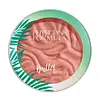What's inside
What's inside
 Key Ingredients
Key Ingredients

 Benefits
Benefits

 Concerns
Concerns

 Ingredients Side-by-side
Ingredients Side-by-side

Ethylhexyl Methoxycinnamate 7.5%
UV AbsorberEthylhexyl Salicylate 5%
UV AbsorberOctocrylene 7%
UV AbsorberBenzophenone-3 6%
UV AbsorberTitanium Dioxide 5.7%
Cosmetic ColorantWater
Skin ConditioningPropylene Glycol
HumectantGlycerin
HumectantDimethicone
EmollientVp/Eicosene Copolymer
Cyclomethicone
EmollientStearic Acid
CleansingDimethiconol
EmollientPotassium Cetyl Phosphate
EmulsifyingGlyceryl Stearate
EmollientPEG-100 Stearate
Aluminum Hydroxide
EmollientDisodium EDTA
Tocopherol
AntioxidantTriethanolamine
BufferingPhenoxyethanol
PreservativeEthylparaben
PreservativeChlorphenesin
AntimicrobialCetyl Alcohol
EmollientCarbomer
Emulsion StabilisingMethylparaben
PreservativeXanthan Gum
EmulsifyingEthylhexyl Methoxycinnamate 7.5%, Ethylhexyl Salicylate 5%, Octocrylene 7%, Benzophenone-3 6%, Titanium Dioxide 5.7%, Water, Propylene Glycol, Glycerin, Dimethicone, Vp/Eicosene Copolymer, Cyclomethicone, Stearic Acid, Dimethiconol, Potassium Cetyl Phosphate, Glyceryl Stearate, PEG-100 Stearate, Aluminum Hydroxide, Disodium EDTA, Tocopherol, Triethanolamine, Phenoxyethanol, Ethylparaben, Chlorphenesin, Cetyl Alcohol, Carbomer, Methylparaben, Xanthan Gum
Talc
AbrasiveAlumina
AbrasiveMica
Cosmetic ColorantDimethiconol Stearate
EmollientIsostearyl Neopentanoate
EmollientAstrocaryum Murumuru Seed Butter
EmollientParfum
MaskingOctyldodecyl Stearoyl Stearate
EmollientPolybutene
Isopropyl Isostearate
EmollientLauroyl Lysine
Skin ConditioningAstrocaryum Tucuma Seed Butter
EmollientTheobroma Grandiflorum Seed Butter
Skin ConditioningTin Oxide
AbrasiveTocopherol
AntioxidantLecithin
EmollientAscorbyl Palmitate
AntioxidantGlyceryl Stearate
EmollientGlyceryl Oleate
EmollientCitric Acid
BufferingCaprylyl Glycol
EmollientHexylene Glycol
EmulsifyingPhenoxyethanol
PreservativeCI 77891
Cosmetic ColorantIron Oxides
CI 77492
Cosmetic ColorantCI 77499
Cosmetic ColorantCI 15850
Cosmetic ColorantCI 77007
Cosmetic ColorantTalc, Alumina, Mica, Dimethiconol Stearate, Isostearyl Neopentanoate, Astrocaryum Murumuru Seed Butter, Parfum, Octyldodecyl Stearoyl Stearate, Polybutene, Isopropyl Isostearate, Lauroyl Lysine, Astrocaryum Tucuma Seed Butter, Theobroma Grandiflorum Seed Butter, Tin Oxide, Tocopherol, Lecithin, Ascorbyl Palmitate, Glyceryl Stearate, Glyceryl Oleate, Citric Acid, Caprylyl Glycol, Hexylene Glycol, Phenoxyethanol, CI 77891, Iron Oxides, CI 77492, CI 77499, CI 15850, CI 77007
 Reviews
Reviews

Ingredients Explained
These ingredients are found in both products.
Ingredients higher up in an ingredient list are typically present in a larger amount.
Glyceryl Stearate is a mix of glycerin and stearic acid.
It is used to stabilize the mixing of water and oil ingredients. By preventing these ingredients from separating, it can help elongate shelf life. It can also help thicken the product's texture.
As an emollient, it helps soften skin and supports barrier-replenishing ingredients.
In cosmetics, Glyceryl Stearate is often made from vegetable oils or synthetically produced.
This ingredient may not be fungal-acne safe
Fun fact: The human body also creates Glyceryl Stearate naturally.
Learn more about Glyceryl StearatePhenoxyethanol is a preservative that has germicide, antimicrobial, and aromatic properties. Studies show that phenoxyethanol can prevent microbial growth. By itself, it has a scent that is similar to that of a rose.
It's often used in formulations along with Caprylyl Glycol to preserve the shelf life of products.
Tocopherol (also known as Vitamin E) is a common antioxidant used to help protect the skin from free-radicals and strengthen the skin barrier. It's also fat soluble - this means our skin is great at absorbing it.
Vitamin E also helps keep your natural skin lipids healthy. Your lipid skin barrier naturally consists of lipids, ceramides, and fatty acids. Vitamin E offers extra protection for your skin’s lipid barrier, keeping your skin healthy and nourished.
Another benefit is a bit of UV protection. Vitamin E helps reduce the damage caused by UVB rays. (It should not replace your sunscreen). Combining it with Vitamin C can decrease sunburned cells and hyperpigmentation after UV exposure.
You might have noticed Vitamin E + C often paired together. This is because it is great at stabilizing Vitamin C. Using the two together helps increase the effectiveness of both ingredients.
There are often claims that Vitamin E can reduce/prevent scarring, but these claims haven't been confirmed by scientific research.
Learn more about Tocopherol